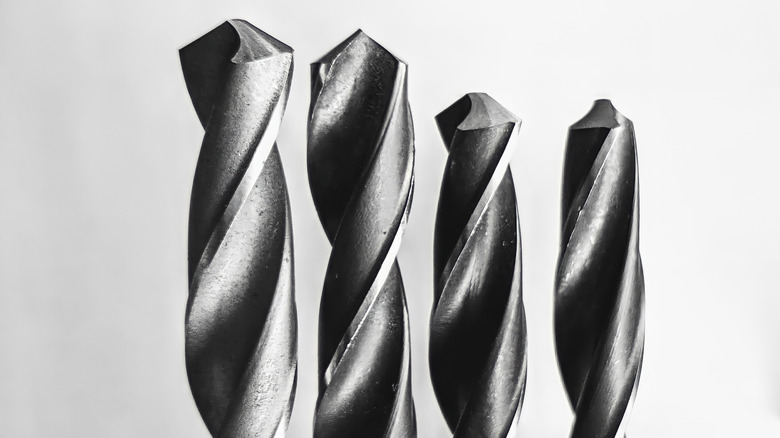Ken Sederquist, WWII Naval Aviation Pilot, VP-71 Written by Helen Sederquist Eglett Based on Ken’s few comments, official documents, websites,… The post Orders to Pearl Harbor appeared first on Pearl Harbor Aviation Museum.
Ken Sederquist, WWII Naval Aviation Pilot, VP-71
Written by Helen Sederquist Eglett
Based on Ken’s few comments, official documents, websites, and references. Please visit www.orderstopearlharbor.com to see a 25-minute tribute video and subscribe to the website.
ENLISTED NAVAL AVIATION PILOT
Ken joined the Navy in 1934 as an Apprentice Seaman and became an Aviation Metalsmith in 1936. He received an honorable discharge in mid-1938, yet re-enlisted within a few weeks. After several months aboard the USS Lexington, he was sent to flight school in 1939 at Naval Air Station (NAS) Pensacola, and was trained on seaplanes. In March of 1940, he earned his wings as a Naval Aviation Pilot (NAP). In May, he was assigned to VP-51, which patrolled the North Atlantic.
BATTLE OF THE ATLANTIC
VP-51 was re-designated to VP-71 in July of 1941, when Ken began recording his own flight logs as a PBY-5 pilot. VP-71 patrolled the North Atlantic for Nazi U-boats and reported their locations to allies, who attempted to track the U boats down to destroy them. The U.S. was not officially in the War yet. Months before and on December 6, 1941, VP-71 was based out of Naval Station (NS) Argentia, Newfoundland, per Ken’s flight log (below).
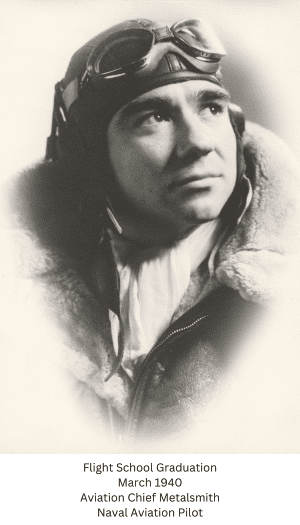

THE PACIFIC WAR
On Sunday, December 7, starting at 7:48 a.m. (Hawaiian Standard Time), for over an hour, the Japanese shockingly attacked Pearl Harbor, killing both servicemen and civilians. The vicious strafing and bombing destroyed ships filled with crews, and our fleet of planes lined up on tarmacs and airstrips at NS Ford Island, NAS Kaneohe Bay, Wheeler Army Airfield, and all other military sites on Oahu.
On December 8, President Roosevelt gave his well-known “Day of Infamy” speech before the country and Congress, which approved declaring war on Japan, only 1 vote shy of unanimously. VP-71 (and VP-72) received their orders to depart for Pearl Harbor. (Captain, 1942)
On December 9, squadrons began arriving at NAS Quonset Point, Rhode Island. Some had detachments with slightly different flight plans (Captain, 1942), managing the number of planes at all Naval Air Stations along the way. For example, on different days, Ken’s squadron went through NAS Pensacola and others went through NAS Jacksonville (per VPNavy.org posts) – both heading for NAS Alameda.
On December 11, the Nazis declared war on the United States.
SUMMARY OF THE JOURNEY
After leaving NAS Argentia, Ken’s PBY-5 No. 2295 stopped at six designated Naval Air Stations around the coasts of the continental U.S. Ken said that extra shielding was incorporated on the seats, and four fuel tanks were added to each plane. The tanks held the extra fuel needed to accomplish the flight from NAS Alameda to Pearl Harbor.
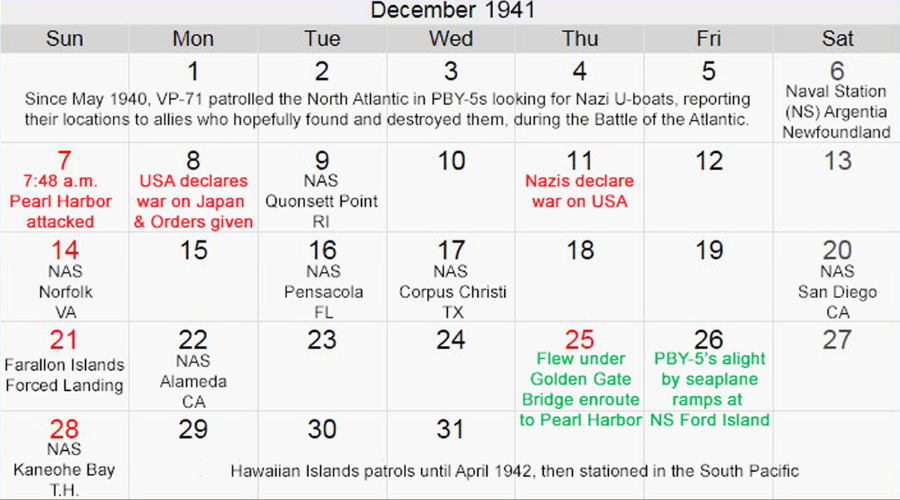
PBY-5’s did not have landing gear, so pilots alighted (set down) and took off in bays. Towing crews connected and disconnected beaching gear (cables and wheels) to pull up or lower down PBY 5’s on seaplane ramps: a dangerous job. Downed-crew rescues on the open oceans were accomplished with PBY-5’s.
Thirty-five miles west of San Francisco, at the craggy shores of the Farallon Islands, they made a “forced landing.” There were attacks by and on Japanese submarines around the Bay area, per the Chronology of 1940-1941 San Francisco War Events (https://sfmuseum.org/war/40-41.html) at The Museum of the City of San Francisco web site.
As the 8 planes of VP-71 departed NAS Alameda (Captain, 1942), the extra weight from the additional shielding, tanks and fuel significantly increased the length of take-off from the San Francisco Bay, and greatly inhibited their rate of climb. The Golden Gate Bridge loomed directly across the Bay, but its tremendous span allowed each aircraft to pass comfortably underneath, just after becoming airborne. That Christmas night, they probably left at a strategic time so they would arrive at Pearl Harbor in daylight and be recognized as allies, during the still-jittery aftermath of the attacks.
They flew at an altitude of around 10 - 15,000 feet above sea level, at a cruising speed of approximately 105 to 125 miles per hour (Wilkinson, 2019), for a total of 18.3 hours. Ken said orders were transmitted, but were never received, to alight at nearby NAS Kaneohe Bay (rather than Pearl Harbor). Their journey from Newfoundland to Pearl Harbor covered close to an astonishing 7,000 miles.
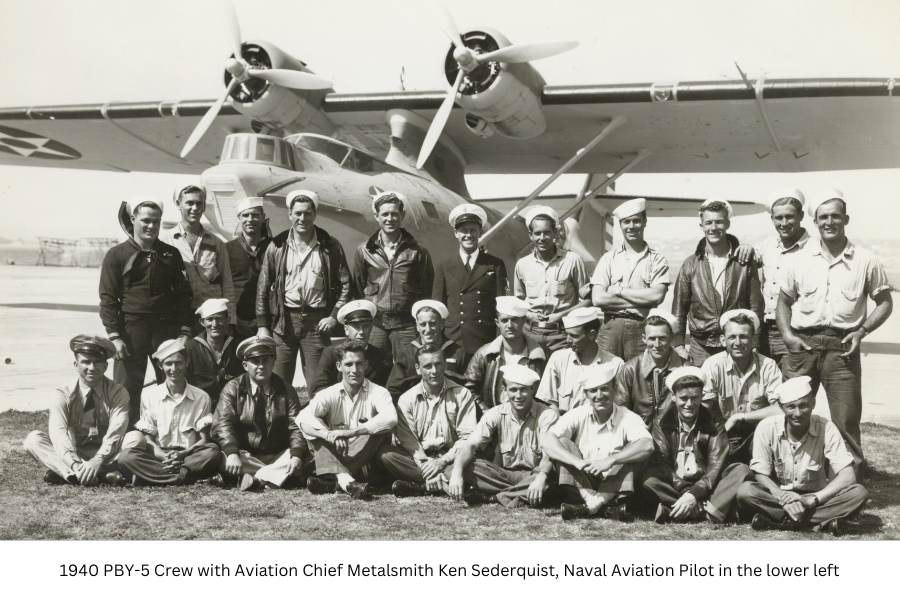
OFFICER AND NAVAL AVIATOR
Ken patrolled the Hawaiian Islands until April 1942, when the Navy honorably discharged him as Enlisted, and immediately reinstated him as an Officer. He was transferred to the South Pacific and spent the next 2 years executing a variety of assignments at many islands and military bases, flying both PBY-5’s and PBY-5A’s, per his flight logs.
Ken married Dolores Main in 1944, and served until 1961 when he retired as a Lieutenant Commander. They had 8 daughters during their many transfers and travels. Ken died in 2003, and Dolores died in 2021. They are buried together at Riverside National Cemetery in California.
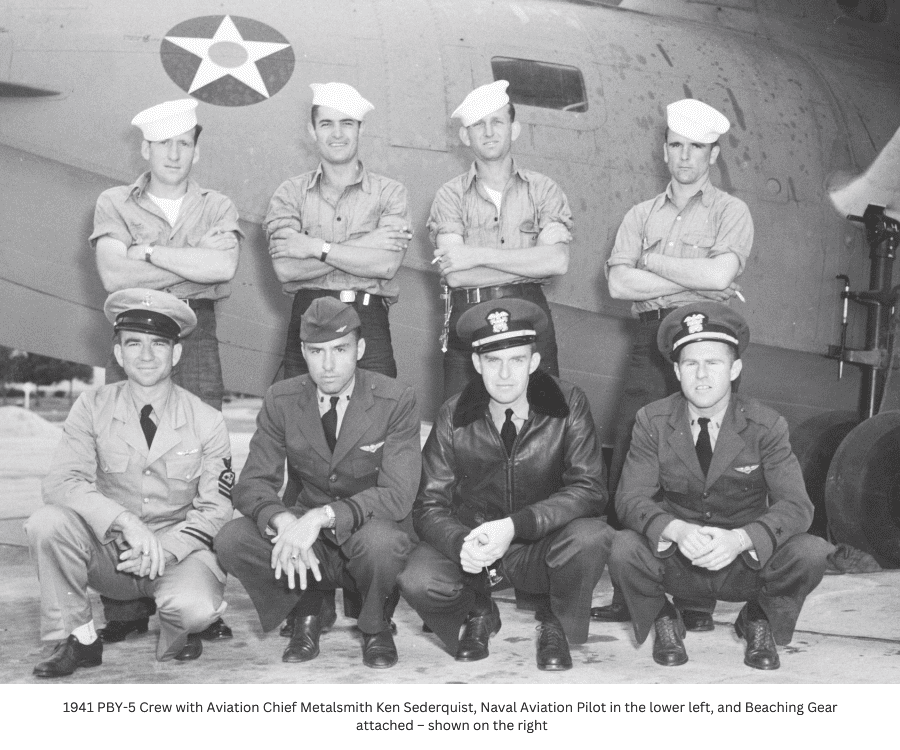
REFERENCES
Ken’s official, approved US Navy Continuous Service Certificate dated 1934 - 1946
Ken’s 4 official, approved USN Flight Logs from 1940 - 1961
Captain J.D. Price, US Navy. 1942. "Commander Patrol Wing EIGHT." War Diary. Washington, DC: US Navy, February 28. Accessed March 10, 2020.
Wilkinson, Stephan. 2019. "Cat Tales: The story of World War II’s PBY Flying Boat." Aviation History Magazine, August 31. Accessed September 9, 2021. https://www.navytimes.com/news/your-navy/2019/08/31/cat-tales-the-story-of-world-war-iis-pby-flying-boat/.
The post Orders to Pearl Harbor appeared first on Pearl Harbor Aviation Museum.





